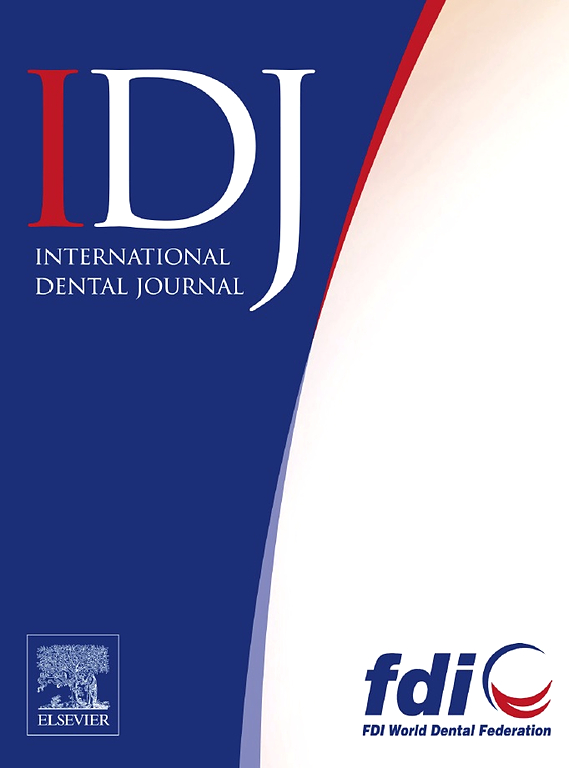成人口腔健康标准问卷的阿拉伯语翻译与验证
IF 3.2
3区 医学
Q1 DENTISTRY, ORAL SURGERY & MEDICINE
引用次数: 0
摘要
成人口腔健康标准集(AOHSS)问卷是由国际牙科联合会(FDI)和口腔成人健康工作组(OHWG)开发的,用于临床环境、研究和人口健康监测中的口腔健康评估。AOHSS包括临床报告的结果测量(CROMs)和患者报告的结果测量(PROMs),包括人口统计、口腔健康和口腔功能、疼痛记录、口腔卫生习惯和治疗费用。这项调查是用英语进行的;它已经在欧洲人群中进行了测试,并被翻译成法语等其他语言。然而,需要阿拉伯语译本将其应用于阿拉伯世界口腔健康的临床和基于人群的研究。本研究旨在将AOHSS问卷中的PROMs部分翻译成阿拉伯文进行验证。方法根据国际药物经济学与结果研究学会(ISPOR)指南,经过前向翻译、后向翻译、专家委员会共识和认知述评等过程,将AOHSS问卷翻译成阿拉伯文。问卷的重测信度采用班级内相关系数(ICC)对30名方便样本进行2周间隔的评估。内部一致性采用Cronbach alpha评价。最终阿拉伯文版本的结构效度与来自不同阿拉伯国籍的100名参与者的有效阿拉伯文口腔健康评估世卫组织问卷进行了检验。参与者完成了两份问卷,并使用Spearman的rho相关系数对结果进行比较。结果阿拉伯语版AOHSS的重测信度评估平均ICC为0.83 (95% CI为0.68 ~ 0.92),一致性极好。Cronbach’s alpha系数为0.75,表明内部一致性满意。建构效度方面,Spearman’s rho相关系数为0.14 ~ 0.90,与WHO问卷具有显著的统计学相关性。结论阿拉伯文AOHSS量表具有良好的信度、内部一致性和效度。本文章由计算机程序翻译,如有差异,请以英文原文为准。
Arabic Translation and Validation of the Adult Oral Health Standard Set Questionnaire
Introduction
The Adult Oral Health Standard Set (AOHSS) questionnaire was developed by the International Dental Federation (FDI) and the Oral Adult Health Working Group (OHWG) for oral health assessment in clinical settings, research and population health surveillance. The AOHSS comprises clinical-reported outcome measures (CROMs) and patient-reported outcome measures (PROMs), including demographics, oral health and oral function, record of pain, oral hygiene practices and treatment cost. This survey was developed in the English language; it has been tested in European populations and translated to other languages such as French. However, an Arabic translation would be needed to apply it for clinical and population-based research on oral health in the Arab world. This study aimed to translate and validate the PROMs section of the AOHSS questionnaire into Arabic.
Methods
The AOHSS questionnaire was translated into Arabic according to the guidelines of the International Society for Pharmacoeconomics and Outcome Research (ISPOR), through a process that included forward translation, backward translation, expert committee consensus and cognitive debriefing. The questionnaire’s test–retest reliability was assessed using the intra-class correlation coefficient (ICC) at a 2-week interval on a convenience sample of 30 subjects. Internal consistency was assessed using Cronbach alpha. Construct validity of the final Arabic version was examined against the validated Arabic Oral Health Assessment WHO questionnaire on 100 participants from different Arab nationalities. The participants completed both questionnaires, and the results were compared using Spearman’s rho correlation coefficient.
Results
The test–retest reliability assessment for the Arabic version of the AOHSS presented an average ICC of 0.83 (95% CI of 0.68-0.92), indicating excellent agreement. Cronbach’s alpha coefficient was 0.75, indicating satisfactory internal consistency. For construct validity, Spearman’s rho correlation coefficient ranged from 0.14 to 0.90, indicating a statistically significant correlation with the WHO questionnaire.
Conclusions
The Arabic version of the AOHSS is good for reliability, internal consistency and validity.
求助全文
通过发布文献求助,成功后即可免费获取论文全文。
去求助
来源期刊

International dental journal
医学-牙科与口腔外科
CiteScore
4.80
自引率
6.10%
发文量
159
审稿时长
63 days
期刊介绍:
The International Dental Journal features peer-reviewed, scientific articles relevant to international oral health issues, as well as practical, informative articles aimed at clinicians.
 求助内容:
求助内容: 应助结果提醒方式:
应助结果提醒方式:


